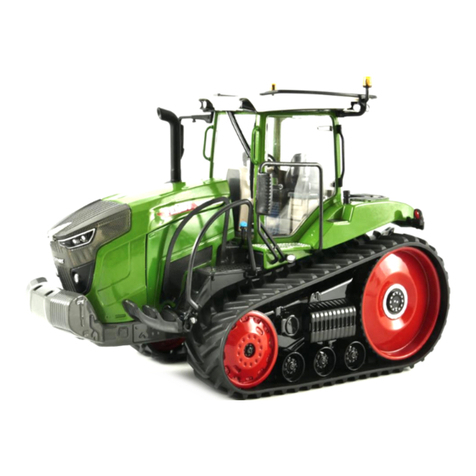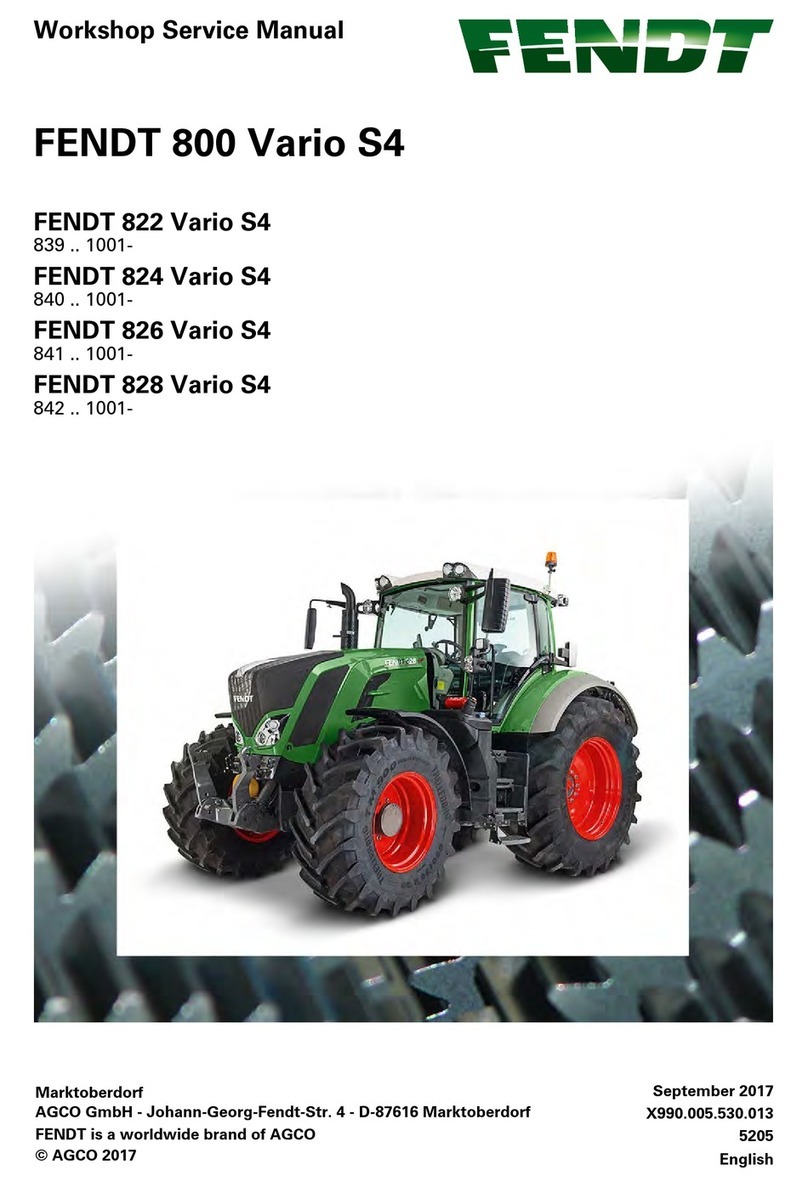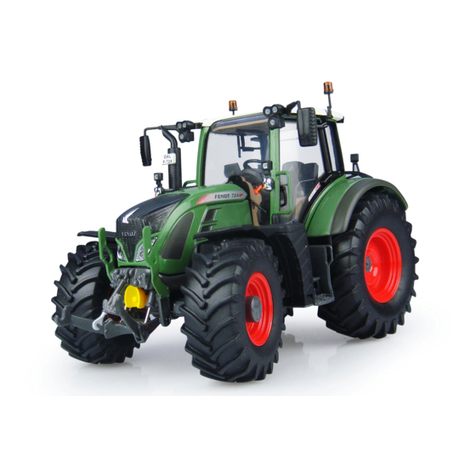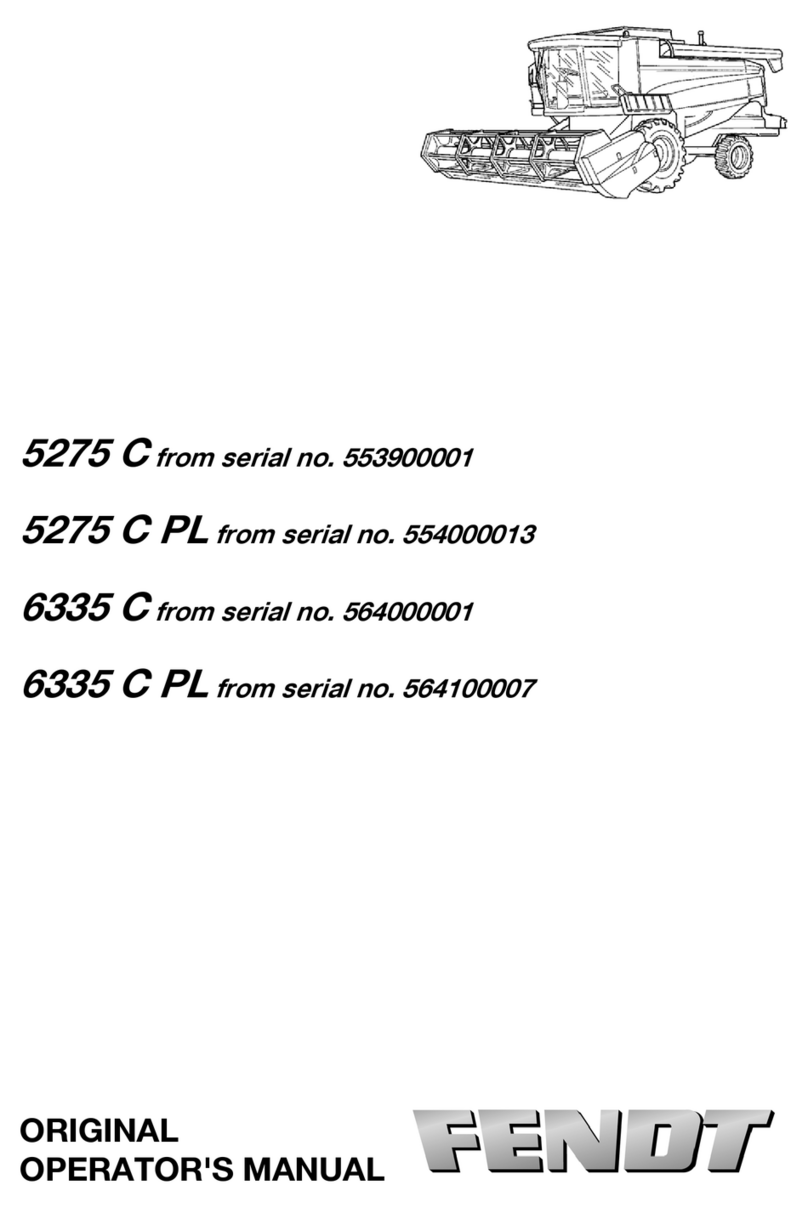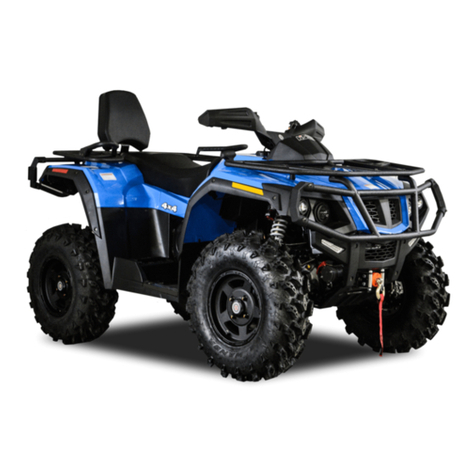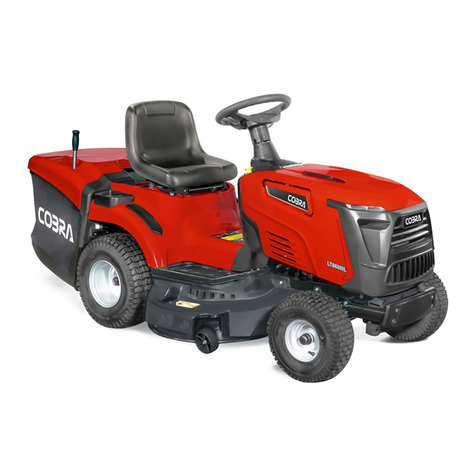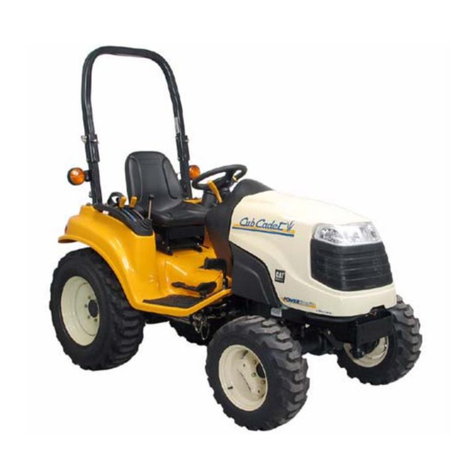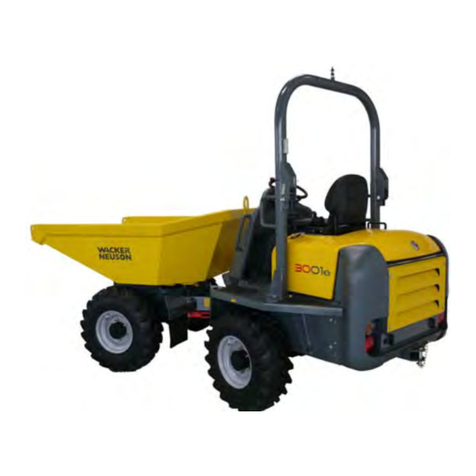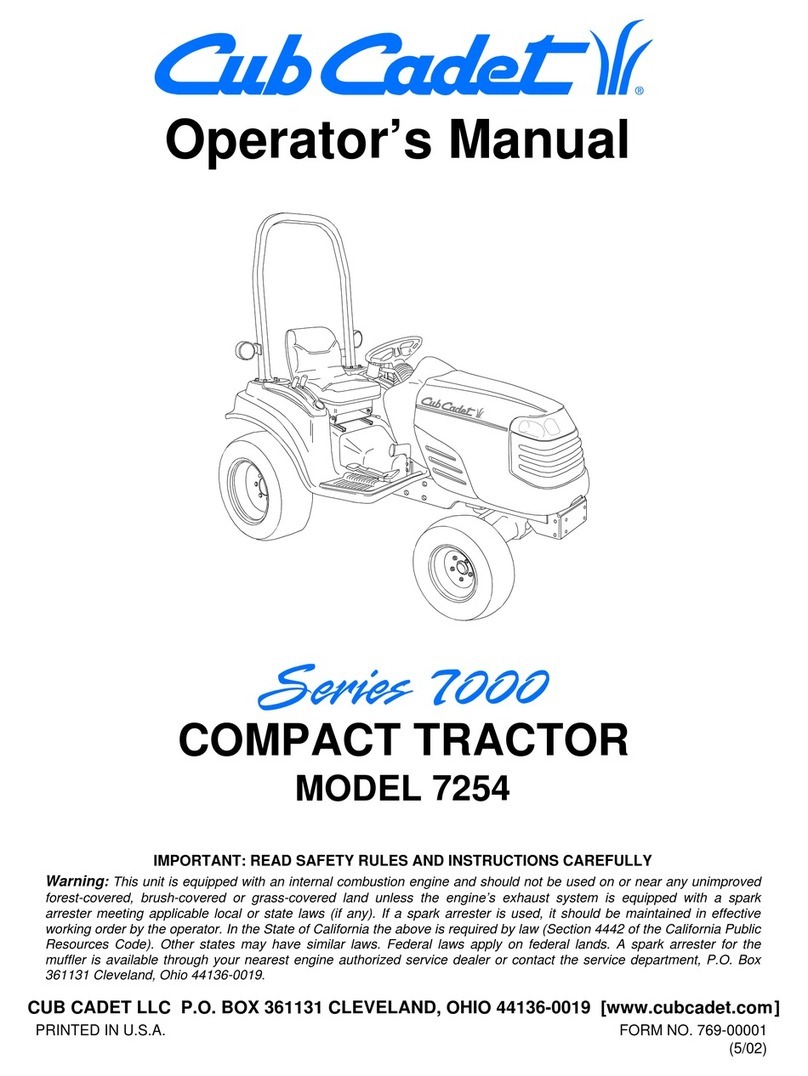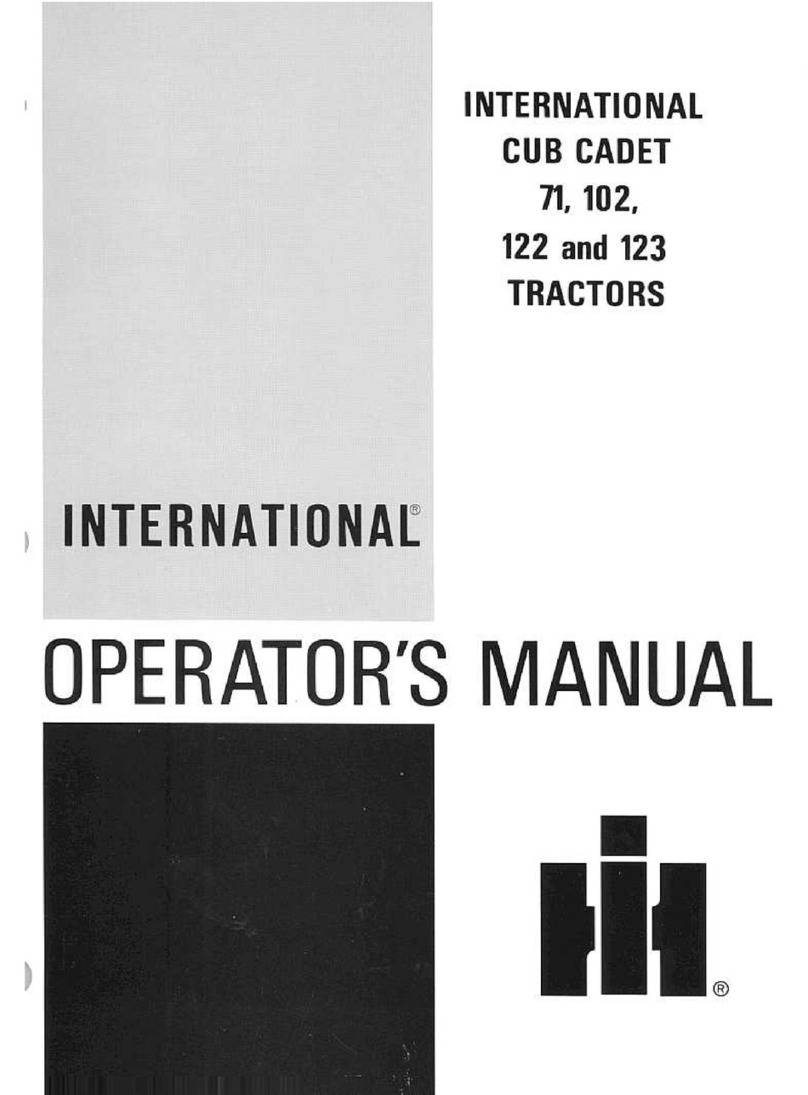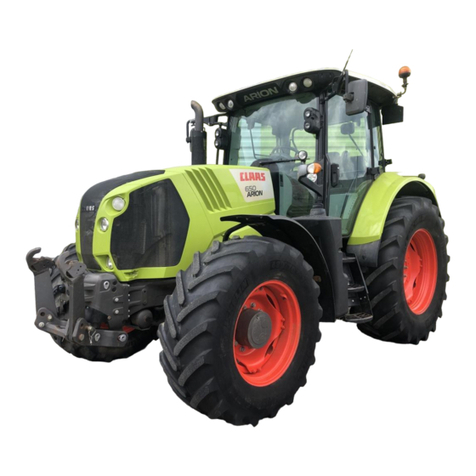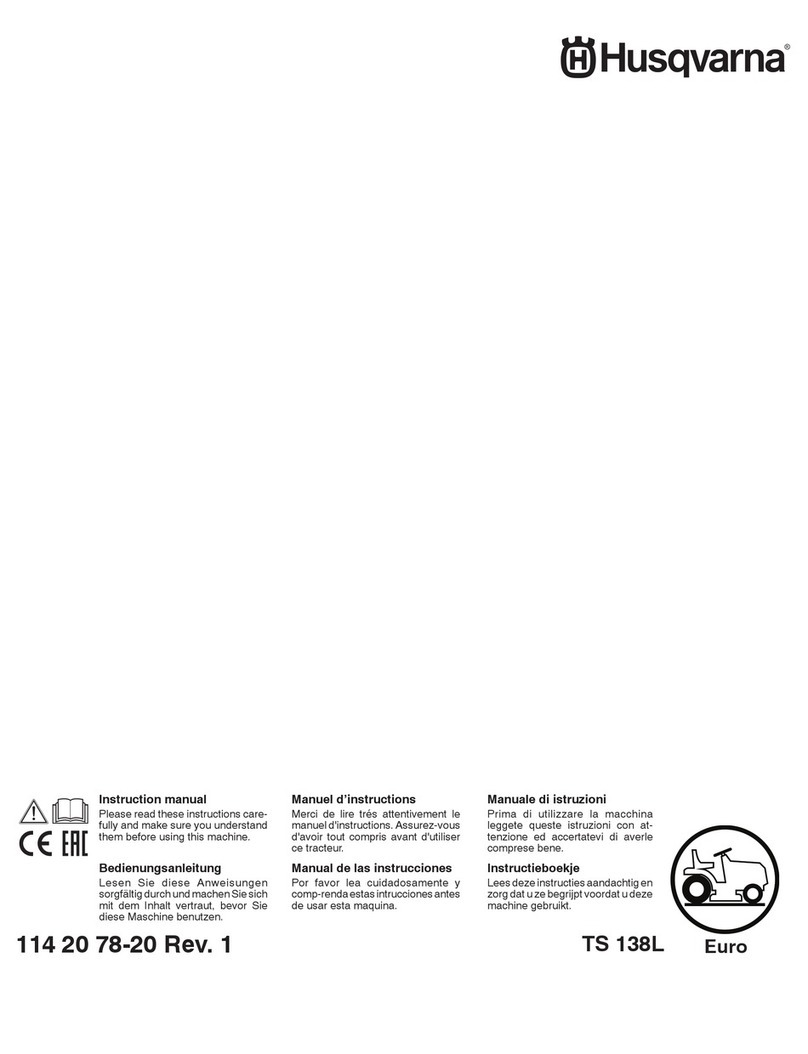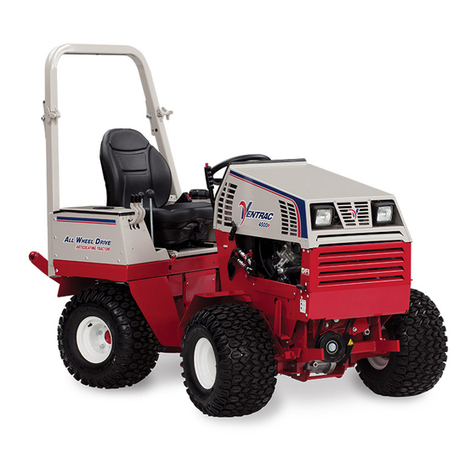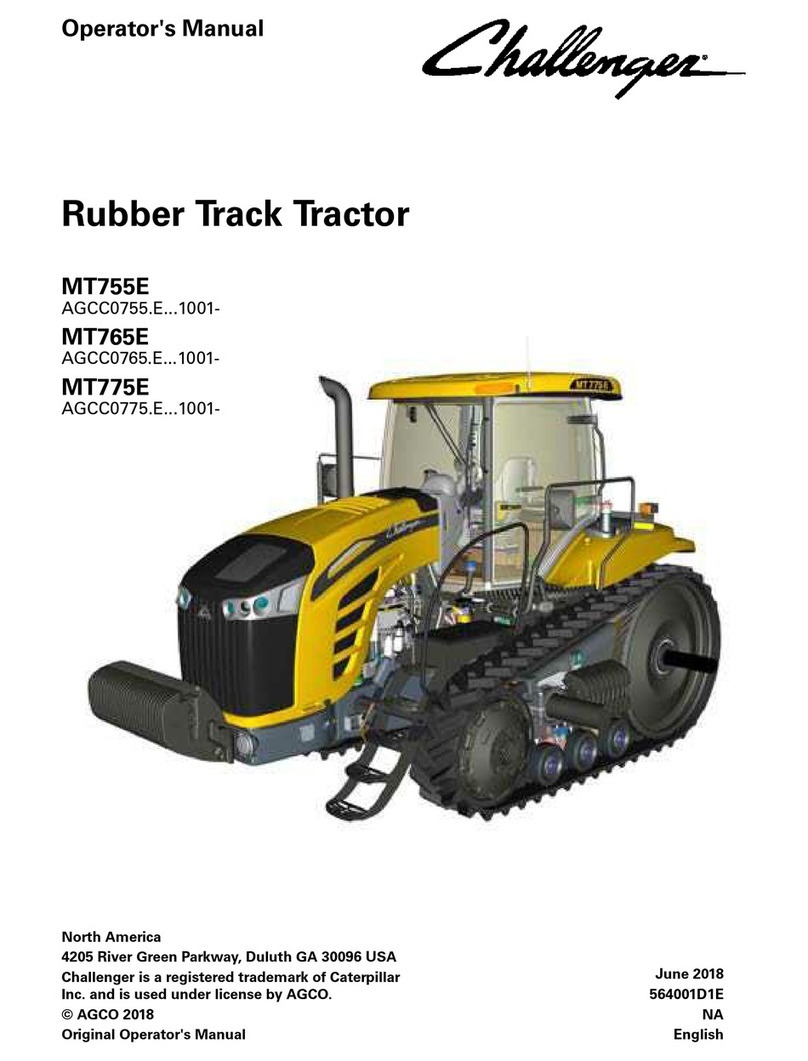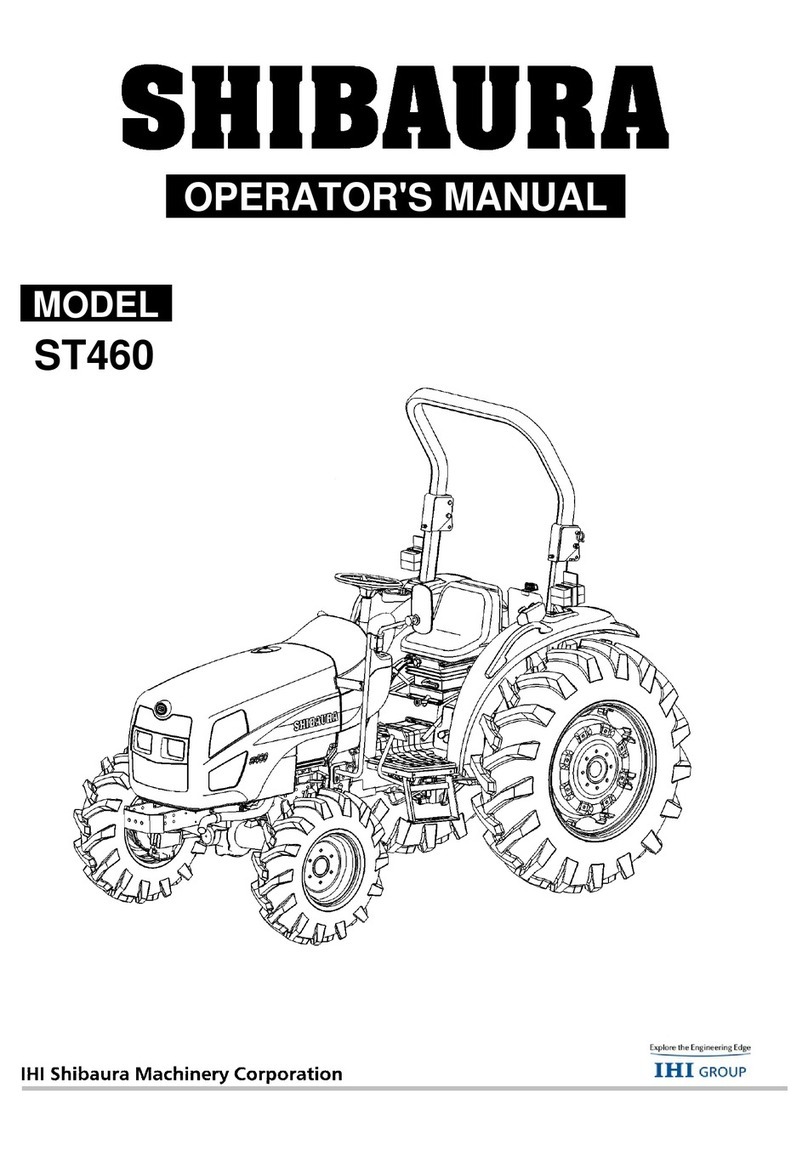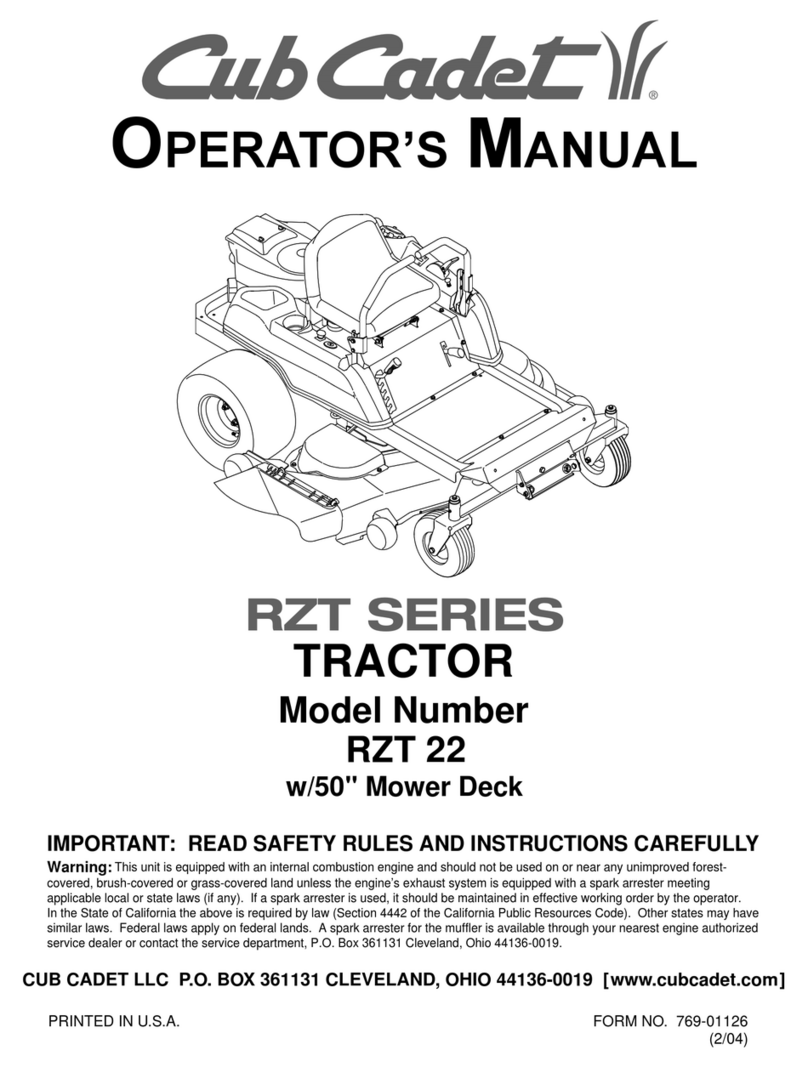FENDT New Leader NL4330G4 User manual

Operator's Manual
Application System
New Leader NL4330G4 EDGE
North America
4205 River Green Parkway, Duluth GA 30096 USA
FENDT is a worldwide brand of AGCO
© AGCO 2020
Original Operator's Manual
May 2020
609146D1A
NA
English

CALIFORNIA
Proposition 65 Warning
WARNING: Diesel engine exhaust and some of its constituents are known to the State of
California to cause cancer, birth defects, or other reproductive harm.
WARNING: Battery posts, terminals and related accessories contain lead and lead compounds,
chemicals known to the State of California to cause cancer, birth defects, or other reproductive
harm. Wash hands after handling.
Congratulations on your selection of an AGCO®Product. We believe you
have exercised excellent judgment in the purchase of your AGCO®
machine. We are most appreciative of your patronage.
Your Dealer has performed the pre-delivery service on your new
machine.
He will discuss with you the operating and maintenance instructions
given in this manual, and instruct you in the correct and varied
applications of this machine. Call on him at any time when you have a
question or need equipment related to the use of your machine.
We recommend that you carefully read this entire manual before
operating the machine. Also, time spent in becoming fully acquainted
with its performance features, adjustments, and maintenance schedules
will be repaid in a long and satisfactory life of the product.
This equipment is covered by a written warranty which will be provided
to you by your AGCO®Dealer at time of purchase.
AGCO®reserves the right to make changes or add improvements to its products at any time
without incurring any obligation to make such changes to products manufactured previously. AGCO
®, or its dealers, accept no responsibility for variations which may be evident in the actual
specifications of its products and the statements and descriptions contained in this publication.
Find manuals at https://best-manuals.com

Application System
1 Safety .................................................................... 7
1.1 A word to the operator ............................................... 9
1.1.1 Safety symbol .................................................. 10
1.1.2 Safety messages ................................................ 10
1.1.3 Information messages ............................................ 10
1.1.4 Follow safety instructions .......................................... 11
1.1.5 Prepare for emergencies ........................................... 11
1.1.6 Exit the cab in an emergency ....................................... 12
1.2 Operate the machine ................................................ 13
1.2.1 Prevent machine runaway .......................................... 14
1.2.2 Use correct lamps and markers ...................................... 14
1.2.3 Operation on slopes .............................................. 14
1.2.4 Travel on public roads ............................................. 15
1.2.5 Stop and park ...................................................15
1.2.6 Overhead Electrical Power Lines ..................................... 15
1.2.7 Avoid Eye Contact with Radar ....................................... 15
1.2.8 Exhaust fumes .................................................. 16
1.2.9 Noise prevention ................................................ 16
1.2.10 Handle fuel correctly ..............................................16
1.2.11 Towing ........................................................17
1.3 Maintenance and service ............................................ 18
1.3.1 Modifications ................................................... 18
1.3.2 Practice correct maintenance ....................................... 18
1.3.3 Chemical safety ................................................. 19
1.3.4 Work in a clean area .............................................. 21
1.3.5 Understand correct service ......................................... 22
1.3.6 Use correct tools ................................................ 22
1.3.7 Support machine correctly ......................................... 23
1.3.8 High pressure fluids .............................................. 23
1.3.9 Service cooling system correctly ..................................... 24
1.3.10 Remove paint before welding or heating ............................... 24
1.3.11 Mobile radio installations .......................................... 24
1.3.12 Fire prevention .................................................. 25
1.4 Safety signs ........................................................ 26
1.4.1 Conveyor ...................................................... 27
1.4.2 Caution ....................................................... 27
1.4.3 Hazardous materials .............................................. 27
1.4.4 High pressure .................................................. 28
1.4.5 Flying material .................................................. 28
1.4.6 Spinner ....................................................... 28
1.4.7 Moving parts ................................................... 29
1.4.8 Falling hazard ................................................... 29
1.4.9 Guard missing .................................................. 29
1.5 Informational signs ................................................. 30
1.5.1 Chain tensioner ................................................. 31
1.5.2 Lube ......................................................... 31
1.5.3 Spread pattern .................................................. 32
1.5.4 Lube chart .................................................... 32
1.5.5 Metering scale .................................................. 32
1.5.6 Spinner scale ................................................... 33
Table of contents
Application System
609146D1A
Find manuals at https://best-manuals.com

2 Introduction .............................................................. 35
2.1 Introduction ........................................................ 37
2.1.1 Intended use ................................................... 37
2.1.2 How to correctly dispose of the waste ................................ 37
2.1.3 Pre-Delivery Inspection checklist ..................................... 37
2.2 Serial number ...................................................... 38
2.2.1 System serial number .............................................38
3 Operation ................................................................ 39
3.1 Controller operation .................................................41
3.1.1 View the run screen .............................................. 41
3.1.2 Home screen icons .............................................. 41
3.1.3 Register the machine ............................................. 42
3.1.4 Configure the machine ............................................ 42
3.1.5 Change the machine settings ....................................... 46
3.1.6 Calibrate the machine components ................................... 50
3.1.7 Make a new job ................................................. 54
3.1.8 Set the bin level ................................................. 56
3.1.9 Find the optimal feedgate height ..................................... 57
3.1.10 Set boundary spreading ........................................... 59
3.1.11 View machine diagnostics ..........................................61
3.1.12 View the machine hydraulics ........................................ 64
3.1.13 Flush the bins .................................................. 65
3.1.14 Lubricate the conveyor chain ........................................67
3.1.15 Put the bins into sequence ......................................... 69
3.1.16 Alarm list ...................................................... 71
3.2 System controls .................................................... 73
3.2.1 Armrest controls ................................................ 73
3.2.2 Control instruments .............................................. 73
3.3 Machine preparation ................................................ 75
3.3.1 Prepare the machine for general operation ..............................75
3.3.2 Prepare the machine for general operation ..............................76
3.4 Spreader preparation ................................................ 77
3.4.1 Spread pattern test kit ............................................ 77
3.4.2 Calibrate the spread pattern ........................................ 77
3.4.3 Crush strength and size grade number ................................ 78
3.4.4 How to do a crush test ............................................ 80
3.4.5 How to do a size grade number test .................................. 81
3.4.6 Spread pattern test procedure ...................................... 83
3.4.7 Troubleshoot the spread pattern ..................................... 85
3.4.8 Find the eective swath width ...................................... 88
3.4.9 Do a check of the swath width ...................................... 89
3.5 Apply material ...................................................... 91
3.6 Unload the material ................................................. 92
3.7 Application system removal and installation .......................... 93
3.7.1 Spreader box lifting points ......................................... 93
3.7.2 Remove the MultApplier ........................................... 93
3.7.3 Install the MultApplier ............................................ 95
3.7.4 Remove the spinner system ....................................... 100
3.7.5 Install the spinner system ........................................ 105
4 Maintenance .............................................................113
4.1 Lubrication and maintenance ....................................... 115
4.1.1 Maintenance introduction ......................................... 115
4.1.2 Lubricant filling reminders ......................................... 115
Table of contents
Application System
609146D1A
Find manuals at https://best-manuals.com

4.1.3 Lubricants and fluids - NL4258G4 EDGE/NL4330G4 EDGE/NL4500G4 EDGE/
NL5000G5 .................................................... 115
4.1.4 Maintenance schedule - NL4258G4 EDGE/NL4330G4 EDGE/NL4500G4 EDGE .. 117
4.2 Hydraulic system maintenance ...................................... 119
4.2.1 Replace the hydraulic oil .......................................... 119
4.2.2 Replace the oil filter ............................................. 120
4.3 System maintenance ............................................... 122
4.3.1 Do a check of the conveyor gearbox oil ............................... 122
4.3.2 Change the conveyor gear box oil ................................... 122
4.3.3 Lubricate the front grease bank ..................................... 123
4.3.4 Lubricate the rear grease bank ..................................... 124
4.3.5 Lubricate the MultApplier idler take-up screws .......................... 125
4.3.6 Do a check of the conveyor chain tension ............................. 126
4.3.7 Lubricate the conveyor chain ....................................... 127
4.3.8 Do a check of the conveyor chain ................................... 129
4.3.9 Clean the bin sensor ............................................. 129
4.3.10 Do a check of the spinner fins ...................................... 130
4.3.11 Do a check of the spinner deflectors ................................. 130
4.3.12 Do a check of the material dividers and hillside flow dividers ................ 131
4.3.13 Clean the bin sensor ............................................. 131
4.3.14 Remove a conveyor belt shield ..................................... 132
4.3.15 Install a conveyor belt shield ....................................... 134
4.4 Adjustments ....................................................... 137
4.4.1 Adjust the conveyor chain tension ................................... 137
4.4.2 Adjust the MultApplier conveyor chain tension .......................... 138
4.4.3 Adjust a conveyor belt shield ....................................... 138
4.4.4 Adjust the vee hood ............................................. 140
4.4.5 Adjust the MultApplier feedgate .................................... 141
4.4.6 Fold up the hillside divider ......................................... 142
4.4.7 Fold down the hillside divider ...................................... 143
5 Troubleshooting ......................................................... 145
5.1 Troubleshooting ....................................................147
5.2 Spreader module LED light alerts ................................... 150
5.3 Hydraulic schematics ............................................... 152
6 Specifications ........................................................... 157
6.1 Application system specifications ................................... 159
7 Index ................................................................... 161
Table of contents
Application System
609146D1A
Find manuals at https://best-manuals.com

1 Safety
1.1 A word to the operator ................................................... 9
1.1.1 Safety symbol ...................................................... 10
1.1.2 Safety messages .................................................... 10
1.1.3 Information messages ................................................ 10
1.1.4 Follow safety instructions .............................................. 11
1.1.5 Prepare for emergencies .............................................. 11
1.1.6 Exit the cab in an emergency ........................................... 12
1.2 Operate the machine .................................................... 13
1.2.1 Prevent machine runaway ..............................................14
1.2.2 Use correct lamps and markers ......................................... 14
1.2.3 Operation on slopes .................................................. 14
1.2.4 Travel on public roads ................................................. 15
1.2.5 Stop and park ...................................................... 15
1.2.6 Overhead Electrical Power Lines ......................................... 15
1.2.7 Avoid Eye Contact with Radar ........................................... 15
1.2.8 Exhaust fumes ..................................................... 16
1.2.9 Noise prevention .................................................... 16
1.2.10 Handle fuel correctly ................................................. 16
1.2.11 Towing ........................................................... 17
1.3 Maintenance and service ................................................ 18
1.3.1 Modifications .......................................................18
1.3.2 Practice correct maintenance ........................................... 18
1.3.3 Chemical safety ..................................................... 19
1.3.4 Work in a clean area ..................................................21
1.3.5 Understand correct service .............................................22
1.3.6 Use correct tools .................................................... 22
1.3.7 Support machine correctly ............................................. 23
1.3.8 High pressure fluids .................................................. 23
1.3.9 Service cooling system correctly .........................................24
1.3.10 Remove paint before welding or heating ................................... 24
1.3.11 Mobile radio installations .............................................. 24
1.3.12 Fire prevention ..................................................... 25
1.4 Safety signs ............................................................ 26
1.4.1 Conveyor ..........................................................27
1.4.2 Caution ........................................................... 27
1.4.3 Hazardous materials ................................................. 27
1.4.4 High pressure ...................................................... 28
1.4.5 Flying material ...................................................... 28
1.4.6 Spinner ........................................................... 28
1.4.7 Moving parts ....................................................... 29
1.4.8 Falling hazard .......................................................29
1.4.9 Guard missing ...................................................... 29
1.5 Informational signs ..................................................... 30
1.5.1 Chain tensioner ..................................................... 31
1.5.2 Lube ............................................................. 31
1.5.3 Spread pattern ......................................................32
1.5.4 Lube chart ........................................................ 32
1.5.5 Metering scale ..................................................... 32
1.5.6 Spinner scale .......................................................33
Table of contents
Application System 7
609146D1A
Find manuals at https://best-manuals.com

1.1 A word to the operator
It is your responsibility to read and understand the
safety section in this manual and the manual for all
implements before you operate this machine. You
are responsible for your safety. Good safety
procedures prevent injury to you and the persons
around you.
Make the information in the safety section of this
manual a part of your safety procedure. This safety
section is written only for this type of machine.
Safety is your responsibility. You can prevent injury
and death.
This safety section gives basic safety examples
that can occur during the operation and
maintenance of your machine. This safety section
is not a replacement for safety instruction in other
sections of this manual.
Injury or death can occur if the safety instruction is
not obeyed.
Learn how to operate the machine and how to use
the controls correctly.
Do not operate the machine if you do not know
how to operate the machine. Do not let persons
operate the machine that do not know how to
operate the machine.
Follow all safety instructions in the manuals and on
the safety signs on the machine, the implements,
and the attachments.
Use only approved attachments and implements.
Make sure that your machine has the correct
equipment that is necessary by the local
regulations.
WARNING:
Do not use alcohol or drugs that can
have an eect on alertness or
coordination. If you use prescription
or 'over the counter' drugs, get
medical advice about the safe
operation of machines.
CAUTION:
If attachments or implements used
with this machine have a dierent
operator manual, see that operator
manual for other important safety
instructions.
GUID-AC91CCF6-1FF8-4A85-97A1-2D1562806825-high.jpg [High]
Fig. 1
GUID-F38BCC9A-5A98-41F3-BA3C-2C5AB224EDFB [V7]
1. Safety
Application System 9
609146D1A
Find manuals at https://best-manuals.com

1.1.1 Safety symbol
The safety symbol tells you about an area that can
be dangerous!
Look for the safety symbol in this manual and on
the machine. The safety symbols tell you that
there are important safety instructions in the
manual.
GUID-087C8B07-BA1A-4AC8-93FF-E28F097F1E16-high.jpg [High]
Fig. 2
1.1.2 Safety messages
The words DANGER, WARNING or CAUTION are
used with the safety symbol. Learn these safety
messages and obey the recommended
precautions and safety instructions.
DANGER:
If you do not obey the recommended
precautions and safety instructions,
DEATH OR INJURY will occur.
WARNING:
If you do not obey the recommended
precautions and safety instructions,
DEATH OR INJURY can occur.
CAUTION:
If you do not obey the recommended
precautions and safety instructions,
INJURY can possibly occur.
GUID-73F05026-C37B-415A-8140-AD939A283378-high.jpg [High]
Fig. 3
1.1.3 Information messages
The instructions important and note are not related to personal safety. They give information about the
operation and maintenance of the machine.
IMPORTANT:
If you do not follow the special instructions or procedures, you can cause damage to the machine. You can
also cause damage to the process, or the area around the machine.
NOTE: Information to help you do the procedure, or help you to understand.
GUID-5D9F270E-D748-4741-82B1-BE49B78685F2 [V6]
GUID-E54F7740-C021-42A8-8784-4287BE4356C8 [V4]
GUID-9A909F52-D57E-4C30-8CC7-6FDB6D7E9982 [V4]
1. Safety
10 Application System
609146D1A
Find manuals at https://best-manuals.com

1.1.4 Follow safety instructions
Carefully read, learn and understand all safety
messages and or information in this manual and
on machine's safety signs. Keep safety signs in
good condition. Replace missing or damaged
safety signs. Make sure the new equipment
components and or repair parts include current
safety signs. See local dealer for replacement
safety signs.
Never operate machine or equipment without
correct instruction and a complete understanding
of control operation.
Learn to operate the machine and how to use all
controls correctly before operation. Do not let
operator's not authorized operate the machine,
systems and or do service and or maintenance
procedures without correct instruction.
Keep machine, all components and systems, in
correct working condition. Modifications to the
machine not authorized by AGCO can decrease
functionality and or safety, decrease machine life
and void machine warranty.
IMPORTANT: Any modifications to machine or
systems not authorized by AGCO void the
warranty.
GUID-5ED2A984-22F3-401A-BF09-A1E6DFAC1922-high.jpg [High]
Fig. 4
1.1.5 Prepare for emergencies
Keep a first aid kit and a fire extinguisher handy.
Keep emergency numbers for doctors, ambulance
service, hospital, and the fire department readily
available always.
GUID-C89843AC-C77A-4DD7-8AC1-2A669AA59DB7-high.jpg [High]
Fig. 5
GUID-B1AC9269-352E-468C-93A7-DD6248A4DC53 [V2]
GUID-F7D2E4DE-89DA-40A4-89F2-2D29CE2096C0 [V2]
1. Safety
Application System 11
609146D1A

1.1.6 Exit the cab in an emergency
Before starting the procedure
Understand the procedure to use the emergency exit from the right side of the cab before operating the
machine.
Procedure
1. Grab the hammer from the holder.
2. Smash the window.
3. Exit the cab through the window opening.
GUID-23026822-736F-4A82-AD74-3DAB81D3B791-high.jpg [High]
Fig. 6
GUID-6E3ECC39-03EA-4A1D-B632-7A5DB5B6E73B [V2]
1. Safety
12 Application System
609146D1A

1.2 Operate the machine
Procedure
1. Make sure the operator and the ladder areas
are clean and dry to prevent personal injuries.
2. Make sure all wheel bolts are torqued to
correct specifications before operation.
3. Never permit any people on or in the
machine when in operation.
4. Engage park brake and put drive lever in
neutral before starting engine.
5. Stop the machine, turn o the engine, and
set the park brake if an accident occurs.
Remove the key and take the key with before
inspecting any damage.
6. Stop machine immediately if there is an engine, hydraulic system or any failure. Do not turn the key
o until the machine stops and turned o correctly.
7. The operator must not exceed the recommended speeds, loads, or tire inflation. These
recommendations are on the tires and the tire chart located in the operator manual.
8. Never get o a moving machine.
GUID-73472174-86BC-4C6D-8419-A538ECDE7947-high.jpg [High]
Fig. 7
9. When leaving machine unattended, set park
brake, turn o the engine, remove the key
and take the key with.
GUID-CCB62396-F09E-4ED4-B7E4-951AE4379F10-high.jpg [High]
Fig. 8
GUID-D599B6BC-38F2-4F90-9C0B-CBBEA33E77E1 [V5]
1. Safety
Application System 13
609146D1A

1.2.1 Prevent machine runaway
Never bypass start the engine by making a
connection across starter terminals. Engine will
start and machine will move if normal circuits are
bypassed.
WARNING:
Possible injury or death can result
from machine runaway. Never start
the engine while standing on the
ground. Start the engine only from
operator's seat with the seat belt on,
with the drive lever in neutral and
park brake engaged.
GUID-D6874892-5A2F-4157-8648-82F0F8160206-high.jpg [High]
Fig. 9
1.2.2 Use correct lamps and markers
To increase visibility, use the lamps and devices provided. Amber flashing warning lamps and rotating
beacon / strobe beacon, when installed, are recommended whenever driving on public roads unless
prohibited by law. Keep all lamps and markers clean and in correct working order. Replace any missing or
damaged components immediately.
1.2.3 Operation on slopes
Keep the machine in slow speed when going
down slopes. Avoid holes, ditches, and
obstructions to prevent a rollover, especially on
hillsides. Avoid sharp turns on hillsides.
Never drive near edge of a gully or steep
embankment.
GUID-52B4B828-88E8-4B45-ABDB-0AE4EA077D90-high.jpg [High]
Fig. 10
GUID-9D40BC10-B60E-4F53-BE16-720A78222FEA [V2]
GUID-17B8DDF0-8AFE-4842-A714-032776137B3F [V3]
GUID-263F56B3-7F72-4277-8020-0CC1C79793E2 [V3]
1. Safety
14 Application System
609146D1A

1.2.4 Travel on public roads
WARNING: Environmental transportation hazard.
Personal injury or chemical spill can occur.
A loaded machine driven on public roads has a high risk of tire failure. Do not use the
machine for transporting product on public roads.
Always walk around and visually inspect the machine before traveling on public roads. As a warning, honk
the horn twice before starting the engine. Check for damage and or faulty components that can fail and
create a hazardous condition. Make sure all machine systems operate properly including, but not limited to,
front road lights, tail and brake lights, hazard warning lights, park brake, horn, windscreen wiper and
washer, and rear view mirrors. Repair or replace any component not in proper working order.
Never drive at a speed causing the machine to bounce or lose control.
Obey all trac laws. Operate the machine with hazard warning lights or rotating beacon / strobe beacon, if
equipped, on, unless prohibited by law. The use of road lights while traveling on public roads is the
operator's responsibility.
1.2.5 Stop and park
Machine overturns, collisions, runaways, and crushing accidents can occur when an operator ignores safety
procedures.
Failure to signal before you stop, you turn or you slow on public roads, or anywhere can cause a possible
risk.
Pull to the side of the road before you stop.
Be very careful when you stop on slippery surfaces or with heavy loads.
Always engage the parking brake when the machine has stopped.
Remove the key to prevent any personnel not approved from operating the machine.
1.2.6 Overhead Electrical Power Lines
Never let the machine come into contact with
overhead power lines. The radio antenna must be
bent over and secured in place any time overhead
electrical power lines are near the machine. This
can decrease the possibility that the machine may
come into contact with an overhead power line
when in operation or when the machine is
transported.
GUID-7EC381DD-7EAC-4CC9-8211-9993FD2D867C-high.jpg [High]
Fig. 1
1
1.2.7 Avoid Eye Contact with Radar
Radar ground sensors emit a low intensity
microwave signal. The microwave signal will not
cause any ill eects during normal use. Although
the intensity is low, to avoid eye damage, never
look directly into the sensor while the sensor is in
operation.
GUID-11A2F16B-F74A-40CA-AA12-04E51A0AB69D-high.jpg [High]
Fig. 12
GUID-1297D337-508B-4FA7-88ED-BCB0577A38E5 [V5]
GUID-6D57EACC-87C0-486A-A753-AC474AE0AF05 [V4]
GUID-7E4E2EA3-6FD9-4C5B-992A-14695F41F577 [V1]
GUID-4B8E0B85-0729-4BD2-82D3-C0FC9032F049 [V2]
1. Safety
Application System 15
609146D1A

1.2.8 Exhaust fumes
Always work in a correct ventilated area.
Engine exhaust fumes can cause sickness or
death. If necessary to run engine in a closed area,
use correct equipment to safely remove exhaust
fumes from area.
Always open the doors and get outside air into
area.
GUID-14D1976F-1E03-40BF-8B7E-EBFFE3E03995-high.jpg [High]
Fig. 13
1.2.9 Noise prevention
Wear proper hearing protective devices such as
earmus or earplugs to prevent loss of hearing
due to high noise levels.
GUID-48B1B90D-20EB-42DB-A016-3CA0AB8AC168-high.jpg [High]
Fig. 14
1.2.10 Handle fuel correctly
Fuel is very flammable. Handle carefully.
• Always stop the engine before refueling.
• Never refuel while smoking.
• Add fuel in a safe place, away from open
flames or sparks.
• Fill fuel tank outdoors.
• Never fill the fuel tank full.
• Cleanup any spilled fuel immediately.
• Never use diesel fuel, kerosene, gasoline, or
any flammable solvents for cleaning.
• Prevent fire hazards by keeping machine free of
any accumulated trash, grease, and debris.
• Always have, and be prepared to use, a
multipurpose dry chemical fire extinguisher
during operation and while refueling.
GUID-F973C46A-C6B9-4E58-A040-DDEFD6DBE1F9-high.jpg [High]
Fig. 15
GUID-7F41C7C3-DACC-46D2-ADC7-531D148964D3 [V2]
GUID-99732186-65C2-4EC3-8EDB-760F7ABE29B7 [V1]
GUID-9A178FCA-F53F-440E-A34E-657614BD6A29 [V2]
1. Safety
16 Application System
609146D1A

1.2.11 Towing
Towing a trailer is not approved by AGCO.
Using machine for towing, creates a hazard and
can void machine and system warranty.
GUID-A62D1A6A-BFA9-4522-BCEF-F9E49172034F-high.jpg [High]
Fig. 16
GUID-427BCFF3-65CA-400D-B9DD-40F839224B27 [V2]
1. Safety
Application System 17
609146D1A

1.3 Maintenance and service
Read and understand maintenance and safety
instructions before performing any maintenance
procedures.
Any maintenance procedures and or repairs must
only be done by trained personnel.
Never change any equipment or add attachments
not approved by AGCO.
GUID-7A2043D6-4BF0-4103-A043-7EAC2FF8C2D7-high.jpg [High]
Fig. 17
1.3.1 Modifications
Welding or changing the chassis in any way (such as adding implement towing hitches) can cause damage
and or failure of components. Modifications not approved by AGCO void machine and or system warranty.
1.3.2 Practice correct maintenance
Never lubricate, service, or adjust any systems or
components while machine is moving.
Never wear a necktie, necklace, scarf, or loose
clothing while working near machine tools or
moving parts.
Tie long hair behind head and wear a hair net.
Remove all jewelry to prevent electrical shorts and
or other personal injury when working with
machine tools or moving parts.
GUID-0AA66BCC-B5FC-46B5-82C2-01F2D748EA68-high.jpg [High]
Fig. 18
GUID-A68922CA-C2A0-4800-8263-852A6064FF48 [V2]
GUID-888E6A4B-BF15-42EB-865A-2080DC33551A [V2]
GUID-20D85144-D83B-41B5-9E2D-04BFDE7B300F [V3]
1. Safety
18 Application System
609146D1A

Stop the engine and remove key.
Let the machine cool.
Keep all parts in good condition and correctly
installed.
Repair any damaged machine systems and or
components immediately.
Replace worn, damaged or broken parts
immediately.
Remove any buildup of grease, oil or debris.
Disconnect electrical system before making
adjustments or welding on machine.
GUID-BC1826DC-0CD8-4F5A-A774-F27A692DD3B7-high.jpg [High]
Fig. 19
1.3.3 Chemical safety
DANGER: Chemical safety hazard.
Personal injury or death can occur.
Wear manufacturer recommended personal protective equipment when handling
hazardous chemicals. Potentially dangerous chemicals used with the equipment include
items such as fuel, lubricants, coolant, hydraulic fluid, paints and adhesives in addition to
the agricultural chemicals being applied.
Always wear approved protective equipment and
clothing recommended by the chemical
manufacturer.
Before reloading the machine, wear personal
protective equipment as required by pesticide use
instructions and the chemical manufacturer
recommendations. Before entering the cab,
remove protective equipment. Store protective
equipment outside the cab in a closed box or
another type of sealable container. Clean any
shoes or boots to remove soil or other
contaminants before entering the cab.
If dangerous chemicals come in contact with the
body, wash immediately according to the chemical
manufacturer's recommendations.
Never put nozzles, tips or other parts to lips to
blow out trash or debris. Have spare tips available
for replacement.
Wear close fitting clothing and correct safety
equipment required.
Wear approved hearing protection such as
earmus or earplugs to protect against loud
noises.
Long exposure to high noise levels can cause
hearing impairment.
GUID-BAFB4DD4-D188-4F9B-A0DC-5729B133A3BA-high.jpg [High]
Fig. 20
GUID-5BE84910-E657-46BF-B9B4-233337F099D1 [V7]
1. Safety
Application System 19
609146D1A

Some cabs use filters that cannot remove
dangerous chemicals.
Follow instructions given by the chemical
manufacturer.
GUID-55072A39-D882-4355-8ABA-05660F3F6EDA-high.jpg [High]
Fig. 21
Clean the machine of dangerous chemicals after
use. During application, chemicals can build up on
the inside and outside of the machine.
GUID-23E0ECDF-A286-4287-8499-8C9F836B2236-high.jpg [High]
Fig. 22
DO NOT do maintenance on the machine until all chemicals have been fully flushed from the outside and
the system.
Select safe areas to fill, flush, calibrate and decontaminate the machine. Select an area where dangerous
chemical will not drift or run o to contaminate people, animals, vegetation, or water supply.
Read all signs and product labels and follow instructions.
Wear approved hand, eye, and body protection recommended by the chemical manufacturer.
Do not inhale dust or fumes.
Do not blow out with breathe waste or unwanted material from nozzles, tips, or other parts which can
contain left-over chemical . Have replacement tips or parts available for replacement.
If contact is made with chemicals or fertilizers, follow the correct treatment on the container.
Always wash hands before touching your face or mouth.
Get medical aid immediately if signs of illness, such as drowsiness or constant fatigue, occur during or
recently after the use of dry or liquid agricultural chemicals or fertilizers.
1. Safety
20 Application System
609146D1A
Table of contents
Other FENDT Tractor manuals
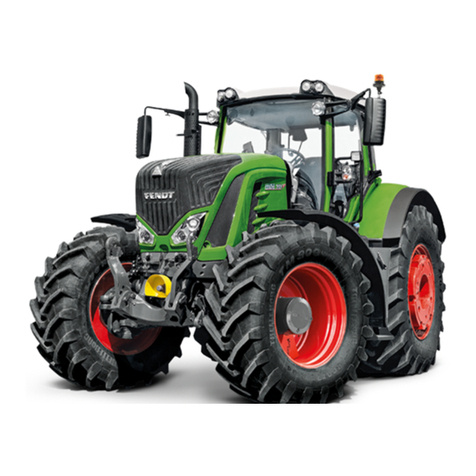
FENDT
FENDT Vario 700 Series User manual

FENDT
FENDT Vario 900 Series User manual

FENDT
FENDT 916 Vario User manual
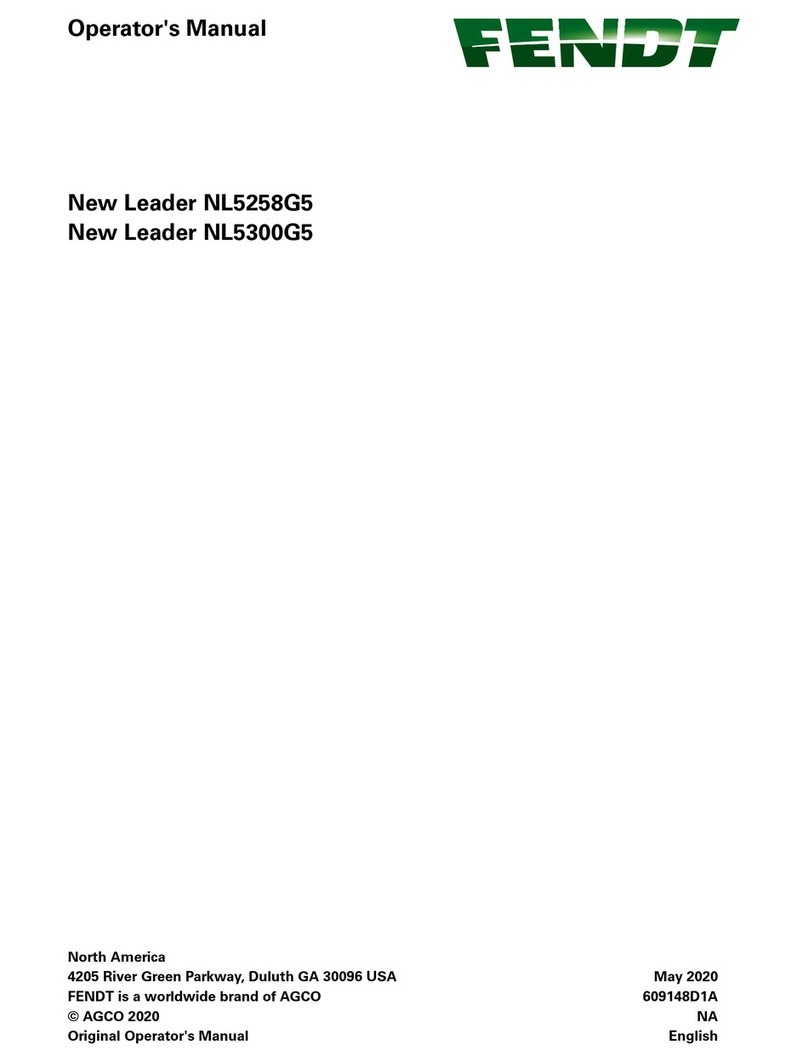
FENDT
FENDT New Leader NL5258G5 User manual
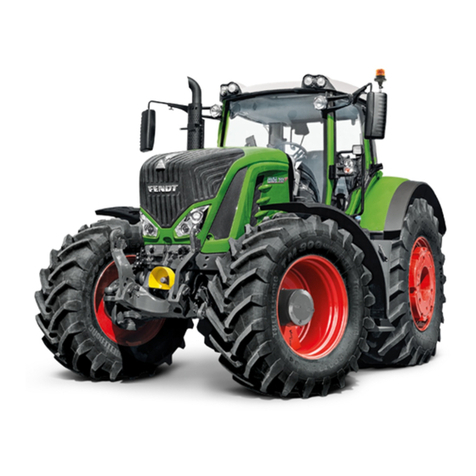
FENDT
FENDT Vario 900 Series User manual

FENDT
FENDT 500 Vario S4 User manual

FENDT
FENDT 916 Vario User manual
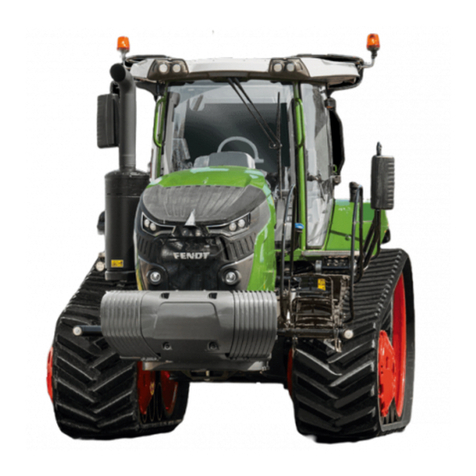
FENDT
FENDT Vario MT 938 User manual

FENDT
FENDT FAVORIT 900 Instruction manual

FENDT
FENDT 1149MT User manual


